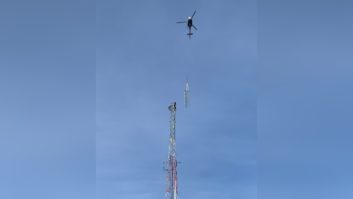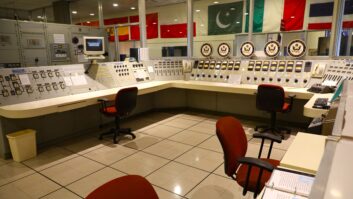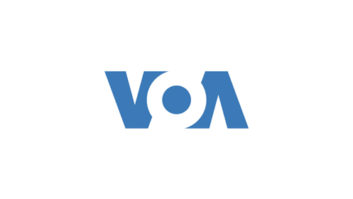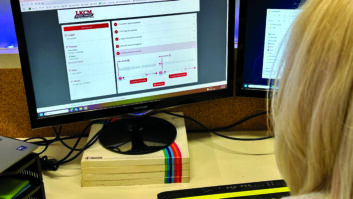Pierre Lonewolf’s career journey that led him to Kotzebue, Alaska in the early 1980s included a stop in a very large California metropolis, where he realized big-city living just wasn’t for him.
You can’t get much farther away from major population bases than northern Alaska. Kotzebue, population 3,283, sits on a sand spit of Alaska’s Arctic west coast just across the Chukchi and Bering Seas and several hundred miles from the Russian eastern frontier. It’s a scenic but scarcely populated place that features abundant wildlife like caribou and moose and bear.
Against that backdrop, Lonewolf, CSRE, CNT, manages engineering services at KOTZ(AM) and KINU(FM) plus a network of FM translators and low-power FMs serving tiny villages. That service includes seven translators and three LPFMs, added beginning in the mid-1980s to serve small river communities around Kotzebue.
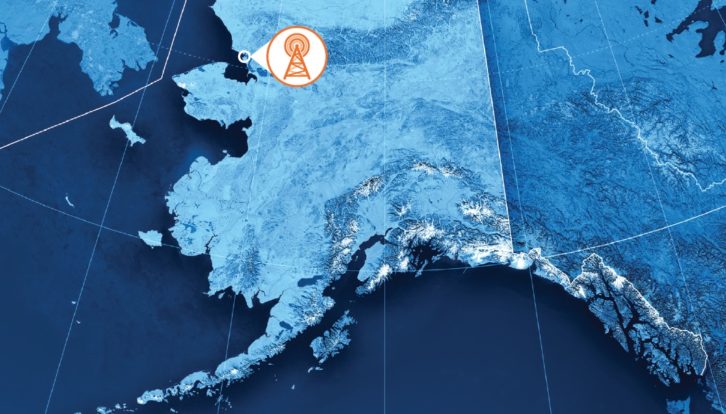
Noncommercial educational KOTZ and KINU are staffed by a few full-time personnel and a volunteer or two. But don’t think of the “Voice of the Arctic” as unsophisticated, Lonewolf says. For instance, KINU broadcasts in HD Radio with HD2 and HD3 channels. Its FM HD2 offers all-talk programming from NPR and BBC while the HD3 channel carries NPR’s Classical 24 programming.
“We went HD probably eight years ago,” Lonewolf says proudly. “It’s just another service that we offer to the audience. I believe in public radio and serving the local community.”
Radio in the blood
Lonewolf, 67, was born on the Turtle Mountain Indian Reservation in North Dakota, where as a child he heard occasional stories in the Ojibwe language from elders and attended several Catholic Indian Mission schools. “Native language was not a priority in those days. I was basically suppressed until about 1973.”
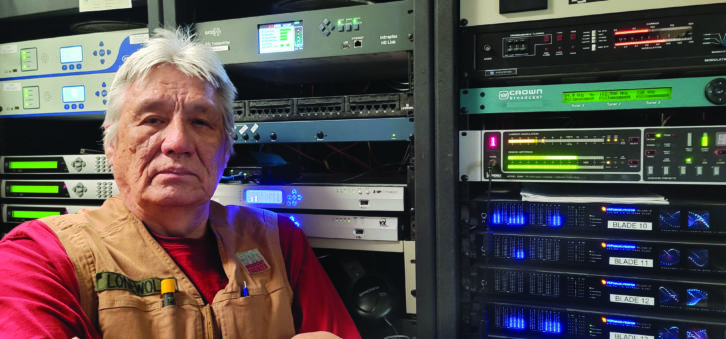
After high school he worked as a lineman/electrician and controls specialist for several power companies, then landed in San Francisco and the School of Communications Electronics in 1977. There he earned his First Class FCC license.
“My dad had started a radio station in Belcourt, N.D., in the mid-1970s and I was hired in as assistant engineer. It was my first radio job. If you’ve never worked for your father, it is way harder than working for someone you are not related to,” Lonewolf said with a chuckle.
“But my father Dallas was a forward thinker. He had no experience in broadcast radio but he just felt it was important for the reservation have a radio station. And that was the reason I went to school in San Francisco — in order to help him at his radio station.”
At KEYA(FM), Lonewolf worked under a mentor, Miles Hustead, and eventually succeeded him as chief engineer several years later. Another job opportunity led Lonewolf to WOBJ(FM) on the Lac Courte Oreilles (LCO) Reservation in Reserve, Wis., and a chance to build what he believes was the first Native American 100,000-watt FM in the country.
“It was a few rough months at sign-on but we worked through it. It was quite the experience for a young man,” Lonewolf said.
[Sign Up for Radio World’s SmartBrief Newsletter]
“Logistics is everything in Alaska”
Lonewolf went north and started at KOTZ in 1983. His time in San Francisco had shown him that he didn’t like the urban environment; he decided that a rural outpost amid the ruggedness of Alaska might be a good fit. Since then he has helped direct major radio technology advances at the stations in Kotzebue through nearly 40 years in charge of engineering.
“In that time we have gone from tube transmitters to solid-state systems. Computers have become the workhorse of radio. Consoles are now networked. And all those wires we ran yesteryear are down to one network cable.”
His responsibilities as a small-market chief may sound familiar to readers in similar circumstances.
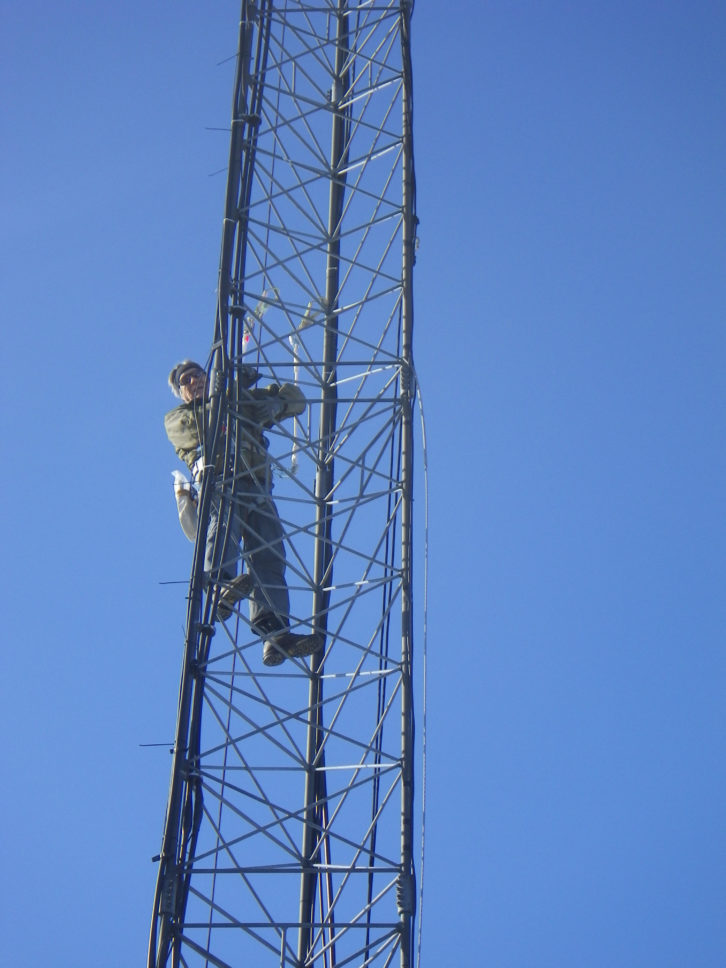
“Like most public radio engineers in small markets, I do everything. From roofing to the plumbing, to wiring and electrical. When you are a rural bush engineer, you just take care of all those things yourself. You typically don’t call for help unless you really need it. I’ve acquired a lot of skills outside of the normal role of broadcast engineer. And that’s OK.”
Lonewolf finds his biggest challenge is obtaining parts when things break. That was true even before the global supply chain issues exacerbated the problem.
“And logistics is everything in Alaska. You can plan for everything on a project, but it’s just hard to get anything moved right now. And the expense of everything — we put in some lighting trusses in our AM studio. They cost $1,200, and the shipping was $2,800. And then it was missing the clamps so we had to wait again for those,” he said.
Fuel jumps around in price dramatically in Alaska, Lonewolf said, and $12 a gallon for gas isn’t uncommon at certain times of the year.
IT work has become a larger part of his duties in recent years. He has had a love of computers since being introduced to them. Like many engineers he has learned most of his IT skills on the job.
“Computers have taken over everything, obviously. In the old days I spent a lot of time working on studio gear and transmitters. Now it seems I mostly do computer work.”
Dramatic seasons
A U.S. Army veteran who participated in Desert Storm and has served in the National Guard in Alaska and North Dakota, he has faced all sort of challenges in maintaining broadcast sites in rural Alaska’s weather.
“The coldest I’ve ever seen it here is negative 65 degrees. And of course the wind was blowing. The winters are very long and dark here,” he said.
“Obviously the weather and the climate present challenges. Mostly the only way to get to some of these villages is by boat, plane or snowmobile in winter.”
Kotzebue Broadcasting’s radio network framework consists of FM translators and low-power Nautel transmitters, in villages like Selawik, Kiana, Noatak and Red Dog Mine. The feed to the translators and LPFMs is via the KOTZ web stream through Triton Digital with Telos Z/IP Stream R/2 encoding.
“At one time we were using AT&T via SCPC for the village feeds, basically a nailed-up voice-grade circuit. Then the internet came along. Our earliest feeds were via Barix Exstreamer 110s. The only issue that has come up … was when our ISP upgraded the system and the reliability of the connection became problematic, and we are still searching for a why.
“It’s interesting that we have gone from SCPC [single channel per carrier], which was very reliable, to DAMA [demand assigned multiple access], which was ok, and now to IP connectivity. I sometimes wish for the old days, but we are where we are.”
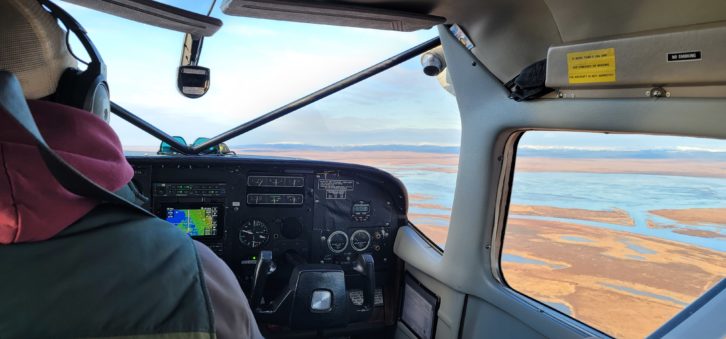
The stations in Kotzebue have replaced studio consoles in recent years with Wheatstone IP-12 and IP-16 surfaces and WheatNet-IP Blade infrastructure.
“We are digital across the board now. Everything is going VoIP. We now have the Telos VX VoIP system. And we have a Nautel AM solid-state transmitter.
“It’s funny, in the old days I spent a lot of time working on transmitters but not anymore. It’s very reliable. We’ve also recently changed out our automation software to PlayoutOne, which offers cloud backup.”
Next up, the stations plan to jump on Bionic Studios from Broadcast Bionics for social media curation and audience engagement. “That is where people live now. You have to be on social media.”
He expects that the future will bring more integration of fiber optic connections in studios and the use of artificial intelligence and voice cloning, with implications for radio. “We are probably not that far from a computer DJ that sounds pretty good.”
The vastness of Alaska doesn’t leave Lonewolf “feeling isolated” like he did prior to the arrival of internet. “When you had to wait for the parts catalogue to arrive, now that was the old days. But staying up with current technology and news is pretty easy now.”
Lonewolf says the noncommercial education programming delivered by his radio stations in rural Alaska is an important component to everyday life in the Kotzebue region.
“When you go out to rural Alaska things are different. Yes, they get cell service in the villages now. But internet speed is very slow typically. The villages are small. From several hundred people to maybe 500 in population. We fill a very important role in rural Alaskan life.”
Wolves as neighbors
Lonewolf lives with his wife, Rosie, in Kotzebue, which is approximately 550 miles northwest of Anchorage. He finds many benefits to this life in a countryside where he has hunted, hiked and fished.
“I’m too old now to climb mountains and cross the tundra. I leave that for my sons and nephews now. I still run into musk ox and wolves occasionally at transmitter sites though.”
Lonewolf has been active with the Association of Public Radio Engineers, currently serving on its board and helping to oversee its scholarship program. APRE uses outreach to encourage others to pursue a career in broadcast technology.
“I tell people this is an awesome career path, if you like technology, audio, music and sound. It’s a unique skill set, knowing computers, transmitters and audio chains. But if a person loves it, this is the perfect job. Now the pay is something different, but I think the pay scale will shake itself out with the next generation of broadcast engineers.”
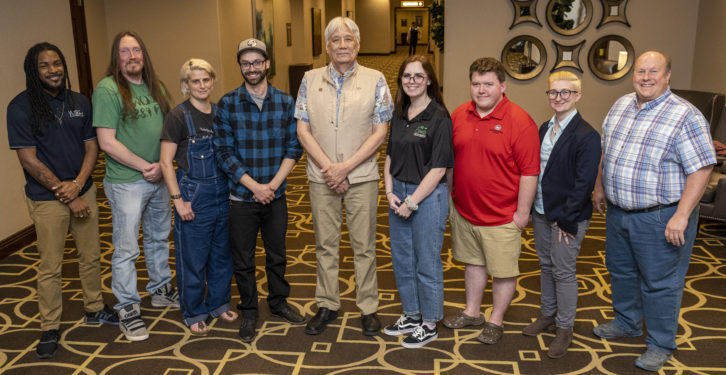
He credits a brotherhood of fellow public radio engineers across Alaska for helping guide him through a variety of technical challenges.
“I couldn’t do my job without the support of all my fellow engineers anyway. The small public radio crowd of engineers. And we all help each other out and give each other moral support. I may look at an issue and I think that’s the way to do it. Then I’ll pop it on the email list and somebody will give me a better idea. We engage quite often. I thank my peers for that support.”
